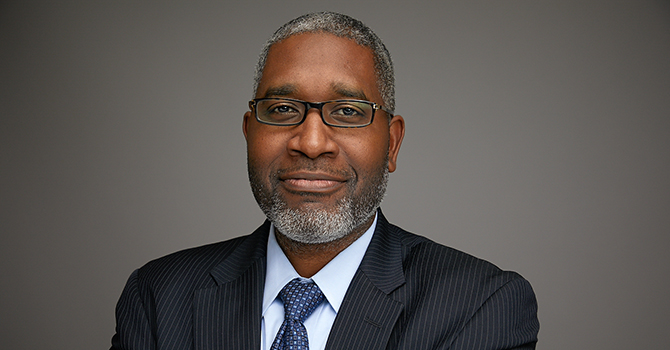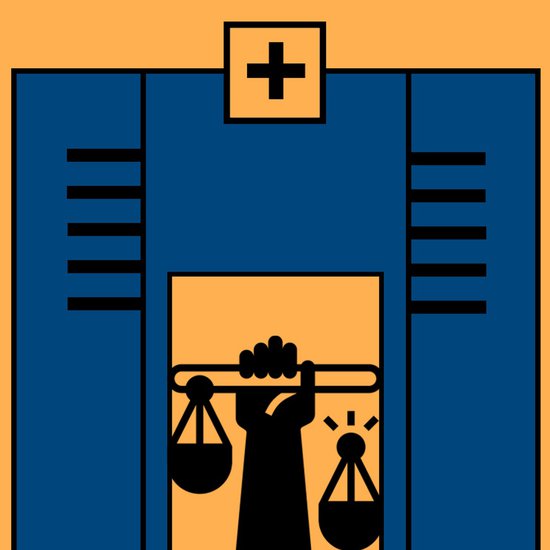
Faculty Spotlight: Ebbin Dotson on immersive learning's power to let healthcare workers feel the emotions needed to address bias
Bias training online course for healthcare workers aims for better care, which leads to better patient outcomes
Ebbin Dotson is an assistant professor in the Department of Health Management and Policy in the School of Public Health. He researches health management and public health infrastructure. While dealing with issues of bias in the workplace, change management and healthcare policy and management present their share of challenges, Dotson says his goals are simple, “I just want things to work well in health care.”
That is why Dotson created the new online training course, Advancing Health Equity: A Guide to Reducing Bias in Healthcare. In the four-week online course, Dotson explores issues of implicit and unconscious bias, organizational awareness, community orientation and professionalism.

Advancing Health Equity: A Guide to Reducing Bias in Healthcare
Bias in healthcare delivery leads to worse patient care and patient outcomes. Advancing Health Equity: A Guide for Reducing Bias in Healthcare provides you an interactive…
The course provides case studies to root learners in issues surrounding language barriers, gender name calling, change leadership and more. The course also uses an enhanced XR experience using interactive 360 degree video to more fully immerse learners in a training scenario.
Dotson answered some questions about his new course, bias in healthcare and the need for strong leaders in order to move the needle on better patient outcomes.
How does bias manifest itself into worse patient outcomes?
Bias is a function of the interpersonal values that make up our personality and attitudes. When at work, these values manifest in our behaviors. And since much of patient treatment and care is based on relational interactions, bias can significantly impact the type of care provided when caregivers and providers let their values influence behavior.
This new course is an online version of an existing in-person health equity skills training program. What made you decide to create this online version?
The course is an expansion of a Ginsberg Center Community Engagement grant and a Kasten Fund population health award project. Our goal was to expand the reach of unconscious bias training for health care professionals. Recognizing the importance and impact, and the success of our existing training modality, this course opens up our reach to a significantly broader health equity stakeholder population.
Your course incorporates extended reality in a role-playing simulation. Why did you feel adding this component would benefit the course?
Trainers and educators recognize the limitations of remote workshops and case studies. Having the option to explore XR was a game changer for behavior-focused workforce training in the way that it has the potential to help all participants see, feel, and participate in the emotional content that is key to learning how to address bias in the workplace.
Watching the final version of the XR 360 case was amazing. The actors were great, the writing was clear and impactful, and XR enhanced a number of the behavior nuances that are impossible to teach in a traditional mode of instruction.
The ability to add an XR designed case makes all the difference in what learners experience as proper health care. Also, the process of working with the Academic Innovation teams is an innovation in itself. The resources at AI provide a very quick response time opportunity for critical training needs.”
Can you talk about the case studies used in the course that are used to explore unconscious and implicit bias?
The cases are the result of our community engagement approach. We worked with some of the most engaged and knowledgeable community health network trainers in the State of Michigan (Oakland, Wayne, Macomb, and Berrien counties). During our train the trainer phase of our initial course development, we needed cases to help learners with takeaways. Instead of adopting cases, we decided to create some of our own. Three of the four cases used in this course were created by our collaborative process, including the XR 360 case.
Why is it so important that an organization reflect the values of the communities that it serves?
I often state that health equity is personal. In this way, we designed our training curriculum to first teach the values and perspectives of community. From this foundation, we then appeal to learners understanding of the dissonance between what communities need to thrive and how they receive care from a biased healthcare system. As a result, we are able to teach each concept rooted in positive community orientation as the goal.